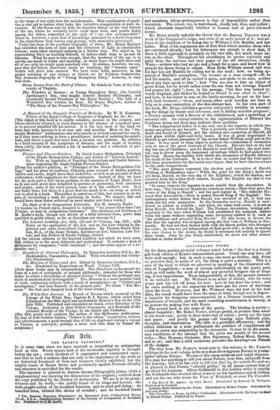ILLUSTRATED POEMS.
Oy the three poetico-pictorial volumes noted below, • the first is a dainty gift-book edition of Keats's transcendent poem. Could one stop here, all
were well enough ; but, in such a case, one must go farther, and, doing so, perceive that, in point of art, the thing is quite a mistake. This is a case of the kind to which we adverted in speaking of the illustrated edi- tion of Longfellow,—a ease of intense individuality on the poet's part, such as will make the work of almost any pictorial designer out of keep- ing, if not impertinent. Even independently of this, the present instance is an unlucky one. Mr. Wehnert is an aitist of ability, who for some years past has left off doing his beat: here he has done his worst ; and he owes nothing to the engravers who have put his score of' drawings upon the wood. However, had Mr. Wehnert done his bust in his best days, the result would have been the same in kind, though not in degree : a capacity for designing unaccompanied by a Protean imagination, an impatience of formula, and the moat trembling sensitivenese to beauty, is no pretext for making free with Keats. The second book is the acme of the pretty. The binding is pretty-.- almost beautiful; Mr. Birket Foster, always pretty, is prettier than usual in his wood-cuts; pretty is their demi-tint of colour ; pretty are the type and paper ; and pretty the looeina—all hearing upon Sabbath joys, thoughts, and observances. The title is a prettified affectation; and the editor italicizes in a note preliminary the prettiest of compliments all round to every one cooperating in the enterprise. It may be in the neces- sary conditions of the attempt that the poets are mostly of the second order,—Mrs. Hemans, Grahame, Mrs. Sigourney, Bishop Mant, Barton, and so on; and that a mild monotony pervades the drawingroom Nature of the designs.
The step from Mr. Foster' wood-cuts in this volume to Mr. Foster's etchings in the next volume is the step from drawiugroom Nature to young- ladies' -album Nature. We tire of this smug neatness and vapid elegance. If a man has anything to tell you about Nature, hear him, and profit from the hearing; but if he has only to tell you that he, the artistic 13o-and-so, is pleased to find Nature "sweetly pretty," by all means entreat bun to go about his business. Oliver Goldsmith in this holiday attire is exactly the Goldsmith who strutted about town to air his handsome suit of clotheo, and not the one who wrote the Vicar of Wakefield, or even The Traveller.
• The Eve of St. Agnes : by John Heats. Illustrated by Edward II. Wehnert.
Published by Condall.
Sabbath-Bells Chimed by the Poets. Illustrated by Birket Foster. Published by
Bell and Daldy.
The Traveller ; a Poem, by Oliver Goldsmith. Illustrated with Etchings on Awl
by Birket Foster. Published by Bogue.


































 Previous page
Previous page